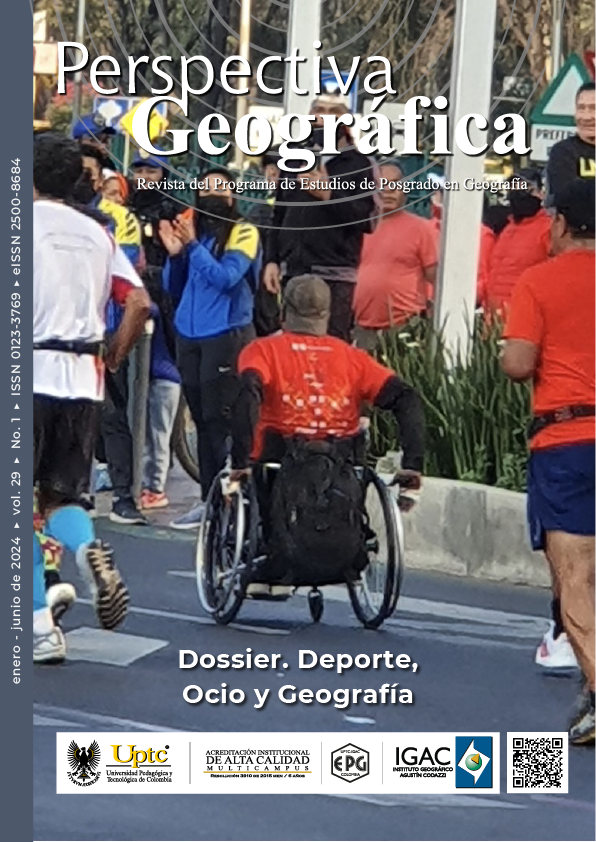Girls, football and emotions: a look from feminist geography

Abstract
Within the work of feminist geography, it is necessary to talk about and make visible the spatial production of girls. The social construction of women from childhood places great emphasis on the geographical profile, since it constitutes identities and subjectivities in itself. However, recent attention in geography on people’s experiences in sports has tended to focus on adult women, with little research on girls and adolescents. Therefore, it is necessary to pay attention to the importance of space and place in terms of children’s participation in sports. Feminist geography has contributed to the visibility of women inside and outside the geographical field. Within the framework of March 8 (8M) 2023, Women’s Day, I held workshops in public spaces, where girls were invited to live together, play soccer and talk about the emotions that the community generated among them. An individual diagnostic mapping of the spatial recognition of the moment was carried out, where the girls captured themselves and shared their feelings orally and in writing.
Keywords
sports, emotions, soccer, gender, girls, spaces, geography
Author Biography
Vanessa Quintana
Geografía. Sistema Universidad Abierta y Educación a Distancia (SUAyED). Facultad de Filosofía y Letras, UNAM, México.
References
- Bacchi, C. and Eveline J. (2010). “Gender Mainstreaming or Diversity Mainstreaming? The Politics of ‘Doing.” In Mainstreaming Politics: Gendering Practices and Feminist Theory, edited by Carol Bacchi and Joan Eveline, 311–334. Adelaide, South Australia: University
- of Adelaide Press.
- Bairner, A. (2014). Emotional grounds: Stories of football, memories, and emotions. Emotion, Space and Society, 12, 18-23. https://doi.org/10.1016/j.emospa.2013.11.005
- Baker, T. A. (2020). Gender, power and identity in women’s long-distance football supporter performance: Finding Football Homes. Gender, Place & Culture, 27(11), 1652-1655. https://doi.org/10.1080/0966369x.2020.1715352
- Baylina Ferré, M., Ortiz Guitart, A., & Prats Ferret, M. (2006). Geografía de la infancia: espacios de juego en ciudades medias de Cataluña. Geographicalia, 50, 5-26. https://doi.org/10.26754/ojs_geoph/geoph.2006501122
- Butler, J. P. (1990). Gender trouble: Feminism and the subversion of identity. Routledge.
- Cartelera Cultural FFyL (2021, junio 10). Espacios de poder: deportes y actividades recreativas #2. [Video]. https://www.youtube.com/watch?v=5gWKx8BPuB8
- Carr, D. S., & Williams, D. R. (1993). Understanding the role of ethnicity in outdoor recreation experiences. Journal of Leisure Research, 25(1), 22–38. https://doi.org/10.1080/00222216.1993.11969907
- Cohen, A.P. (1982) The Symbolic Construction of Community, London: Routledge.
- Davidson, J. & Milligan, C. (2004). Embodying emotion sensing space: Introducing emotional geographies. Social & Cultural Geography, 5(4), 523-532. https://doi.org/10.1080/1464936042000317677
- Evans, B. (2006). ‘I’d feel ashamed’: Girls’ bodies and sports participation. Gender, Place & Culture, 13(5), 547-561. https://doi.org/10.1080/09663690600858952
- Gagen, E. (2000). Playing the part. Performing gender in America’s playgrounds. In Children’s Geographies: Playing, Living, Learning (p. 184).
- Grosz, E., (2010). Feminism, materialism, and freedom. In: Coole, D., Frost, S. (Eds.), New Materialisms, Ontology, Agency, and Politics. Duke University Press, Durham and London, pp. 139–157. https://doi.org/10.2307/j.ctv11cw2wk.9
- Hargreaves, J. (1994). Sporting females: Critical issues in the history and sociology of Women’s Sport. Routledge.
- Holloway, S. L. & Pimlott-Wilson, H. (2011). The politics of aspiration: Neo-liberal education policy, ‘low’ parental aspirations, and primary school extended services in disadvantaged communities. Children’s Geographies, 9(1), 79-94. https://doi.org/10.1080/14733285.2011.540441
- Holloway, S. L. & Valentine, G. (2000). Children’s Geographies: Playing, living, learning. Routledge.
- Holloway, S. L. (2014). Changing Children’s geographies. Children’s Geographies, 12(4), 377-392. https://doi.org/10.1080/14733285.2014.930414
- Holt, L. & Holloway, S. L. (2006). Theorising other childhoods in a globalised World. Children’s Geographies, 4(2), 135-142. https://doi.org/10.1080/14733280600806817
- Jeffrey, C. (2010). Geographies of children and youth I: Eroding maps of life. Progress in Human Geography, 34(4), 496–505. https://doi.org/10.1177/0309132509348533
- Johnson, N. C. (2002). Mapping monuments: The shaping of public space and cultural identities. Visual Communication, 1(3), 293–298. https://doi.org/10.1177/147035720200100302
- Lan, D. (2016). Los estudios de género en la geografía argentina. In Geografías feministas en diversas latitudes. Orígenes, desarrollo y temáticas contemporáneas (p. 55). essay, Instituto de Geografía, UNAM.
- Longhurst, R. (2001). Bodies: Exploring fluid boundaries. London: Routledge.
- Massey, D. B. & Bernal, G. E. (1998). Espacio, lugar y género. [Traducción de Gloria Elena Bernal]. Debate Feminista, 17, 39-46. https://doi.org/10.22201/cieg.2594066xe.1998.17.428
- McDowell, L. (1999). Gender, identity and place: Understanding feminist geographies. Polity Press.
- Nelson, L. & Seager, J. (2005). A companion to Feminist Geography. Blackwell. https://doi.org/10.1002/9780470996898
- Olivares, M. & Escutia, B. (2019). Mapeando los territorios urbano rurales. Mapeos comunitarios para la defensa y la gestión territorial frente a la urbanización y los megaproyectos en la defensa identitaria y territorial. En Grupo de Investigación Espacio, Tecnología y Participación (ESTEPA), Memorias II Taller Internacional de Creación Cartográfica. Acciones para la construcción de nuevas narrativas territoriales (pp. 21-33). Universidad Nacional de Colombia. https://www.researchgate.net/profile/Julieth-Monroy-Hernandez/publication/335967566_Memorias_II_Taller_Internacional_de_Creacion_Cartografica_Acciones_para_la_construccion_de_nuevas_narrativas_territoriales/links/5d869fada6fdcc8fd60bf4c7/Memorias-II-Taller-Internacional-de-Creacion-Cartografica-Acciones-para-la-construccion-de-nuevas-narrativas-territoriales.pdf
- Ortiz Guitart, A. (2007). Geografías de la infancia: descubriendo “nuevas formas” de ver y de entender el mundo. Documents d'anàlisi geogràfica, 49, 197-216.
- Ortiz Guitart, A. (2012). Cuerpo, emociones y lugar: aproximaciones teóricas y metodológicas desde la geografía. Geographicalia, 62, 115-131. https://doi.org/10.26754/ojs_geoph/geoph.201262850
- Pavlidis, A. (2018). Making “space” for women and girls in sport: An agenda for Australian geography. Geographical Research, 56(4), 343-352. https://doi.org/10.1111/1745-5871.12302
- Pavlidis, A. (2020). Being grateful: Materalising ‘success’ in women’s contact sport. Emotion, Space and Society, 35, 100673. https://doi.org/10.1016/j.emospa.2020.100673
- Rose, G. (1993). Feminism and geography: The Limits of Geographical Knowledge. Wiley.
- Smith, M., Davidson, J., Cameron, L., & Bondi, L. (2016). Emotion, place, and culture. Routledge. https://doi.org/10.4324/9781315579238
- Tang, V. (2015). ‘The tables have turned’: Sport, emotion & the passive counter-politics of youth citizenship. Emotion, Space and Society, 15, 19-28. https://doi.org/10.1016/j.emospa.2015.04.004